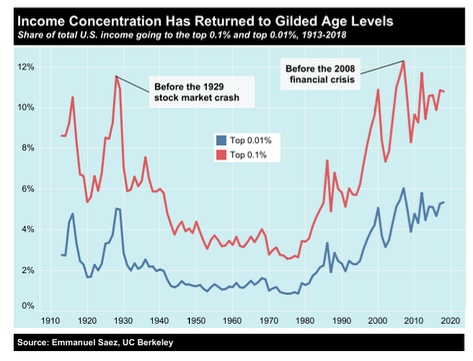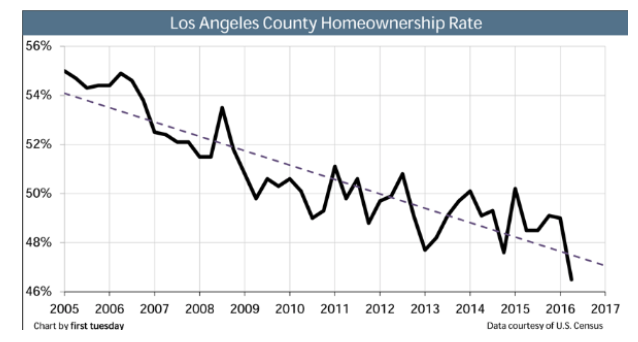CommentsPLANNING WATCH-Like the country as a whole, Los Angeles is caught in a downward economic spiral of its own making. A City Hall-assisted housing crisis has been made worse by economic inequality, while City Hall’s counterproductive, trickle-down responses have created even more economic inequality. These two processes feed on each other, and the objective result is that the rich get even richer at the expense of everyone else.
A few data points reveal how massive economic inequality has become in the United States, how it is getting worse, and how it prices out millions of Americans from housing in good times, and even more in bad times, such as the Great Recession. Beginning in 2007, at least seven million families lost their homes. Most of them became renters, while the foreclosure kings who bought their houses – Steve Mnuchin and Wilbur Ross – are now Trump cabinet members.
UC Berkeley economist Emanuel Saez has documented how economic inequality in the United States increased from it low point in the late 1970s, to its current level, which matches the 1920s. According to Prof. Saez, the top .1 percent (.001) of earners have incomes that are, on average, 196 times greater than the bottom 90 percent. If we look more closely at this 90 percent, 140 million of them live in official or unofficial poverty.

While the housing crisis effects all portions of the U.S. population, those at the top can easily absorb increased housing costs, even for luxury apartments, such as the Caruso building at 8500 Burton Way. According to the Los Angeles Times its penthouses rent for $40,000 per month, while its other apartments typically cost $12,000 per month.
This increasing income inequality is one of the most important factors contributing to homelessness. When rents go up and incomes are stagnant or declining, too many existing residents are priced out of their houses or apartments. According to KCBS News, in Los Angeles the rent for a one- bedroom apartment increased by 84 percent between 2010 and 2018. During the same period incomes only rose by 11 percent. While LA has experienced a housing and McMansions boom during this same period, this new housing is expensive, and it also pulls up the rents of existing apartments and houses. As a result, CBS News reports that those who can no longer afford rent increases are pushed out. They then have fewer places where they can afford to live, forcing many of them to sleep in cars or on the streets.
The construction of so much new, expensive housing is not a fluke. It is the consequence of many City Hall ordinances and practices. For example, various up-zoning schemes have already expanded LA’s untapped zoning capacity by over 20 percent. According to the General Plan Framework Element, in the mid-1990s LA's zoning build out population was 7.2 million people. Subsequently, LA’s two density bonus programs, SB 1818 and TOC Guidelines, in combination with laws green-lighting Accessory Dwelling Units (“Granny Flats”), lifted this zoning build out figure to approximately 9 million people – more than double LA’s existing population.
Nevertheless, more up-zoning is in the works, an enormous financial benefit to property owners and developers. Local Transit Neighborhood Plans, Community Plan Updates, and Re:code LA would push LA’s zoning capacity even higher. If the State of California eventually imposes statewide SB 50-type up-zoning on top of these local developer giveaways, the goose that lays these golden eggs will soon be foiled by unintended consequences.
First, there are not enough affluent buyers and renters to consume so much luxury housing, the reason why most new apartment buildings post prominent vacancy signs.
Second, new, unplanned apartments and McMansions overwhelm LA’s already fragile infrastructure and services, and these inevitable failures make the city an increasingly unappealing destination. Good weather cannot hide traffic jams, broken sidewalks, and homeless encampments forever.
The downward spiral’s prospects: While the relationship between income inequality and the housing crisis is easy to understand, the unintended consequences are more complicated. The State and City’s “housing” programs to assist developers also create additional economic inequality. This additional economic inequality then compounds the housing crisis and accelerates LA’s downward spiral.
For example, upzoning, whether imposed by Sacramento, or created though municipal ordinances, quickly increase the value of commercial and would-be commercial parcels and buildings. When property owners flip their suddenly more valuable properties, they are only taxed at a low capital gains rate. Or, if they sell a partial ownership in a building, Proposition 13 locks in old property tax rates for the new owner. he investors’ wallets get fatter, while the ranks of those who must rent apartments and houses from them get poorer. These tenants must spend an ever-increasing amount of their fixed incomes to keep a roof over their head. Millions of rent-burdened tenants are then left with less disposable income after they pay their higher rents, while their landlords grow ever richer through rent extraction.
At this point, these former house and condo owners no longer accumulate equity and tax benefits from deductible mortgage interest and property tax payments. The percentage of their income they must pay for housing has increased, but it only covers their rent since mortgages are far beyond the financial reach of most Los Angeles tenants. Rent extraction is now so pronounced in the United States that the home ownership rate has plummeted to an historic low, especially in Los Angeles, the U.S. city with the lowest homeownership rate.

As this downward economic cycle unfolds, it forces millions of homeowners to join the ranks of renters, and for these renters to spend an increasing amount of their family income on housing. When combined with stagnant or declining wages, this process pushes too many people into overcrowded conditions, friends’ couches, or even worse, the streets.
But this downward spiral did not just happen. Federal, state, and city governments created it, and they, therefore, can rescind it. To do so, they must abandon a host of Reagan era supply-side “trickle-up” planning programs that fuel gentrification. n LA, rent control must be strengthened by ending vacancy decontrol and expanding the city’s Rent Stabilization Ordinance to include all housing, not just apartments constructed before 1978. Just as importantly, all upzoning scams, like TOC Guidelines, must be repealed.
Furthermore, the trickle-down rationale behind these wealthfare programs must be continually refuted. It is absolutely “fake news,” and it warrants repeated rebuttals and coordinated political actions to end the investor handouts.
(Dick Platkin is a former Los Angeles city planner who reports on local planning issues for CityWatchLA. He serves on the board of United Neighborhoods for Los Angeles (UN4LA) and is co-chair of the new Greater Fairfax Residents Association. Please send comments and corrections to [email protected].)
-cw
Sidebar

 CityWatch Los Angeles
Politics. Perspective. Participation.
CityWatch Los Angeles
Politics. Perspective. Participation.
18
Thu, Apr













